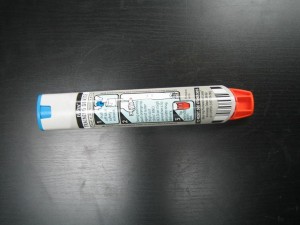If an individual experiences an allergic reaction after sustaining a bee sting, it is vital to call for emergency assistance right away. If you are helping out an individual with a known bee sting allergy and has an on-hand injectable epinephrine, your initial move is to administer a shot if any symptoms of an allergic reaction are manifesting.
In case the individual who is not allergic to bee stings was stung by a bee, it is vital to perform the following steps to monitor for an allergic reaction.
Step 1: Removal of the stinger
Generally, only honeybees leave behind their stingers after delivering a sting due to the barbs present on the stinger. It is vital to remove the stinger as soon as possible, preferably less than 10 seconds after a sting was delivered. This is vital since this minimizes the amount of venom injected.

Step 2: Monitoring the signs of an allergic reaction
Almost everyone, even those who do not have bee sting allergy can experience symptoms such as pain, swelling, redness and itchiness at the sting site. Take note that these symptoms are not dangerous and can be readily managed. Nevertheless, if the individual was stung on the tongue, lips, inside the mouth or throat, it can lead to severe swelling at the sting site which is considered as an emergency.
The symptoms of a severe allergic reaction include the following:
- Lightheadedness
- Difficulty breathing
- Rapid heart rate and feeling faint
- Stomach upset
- Skin rashes or swelling away from the sting site
Remember that these symptoms, if they are going to manifest typically start within a few minutes of being stung. Once these symptoms are present, call for emergency assistance right away or bring the individual to the nearest emergency department.
Step 3: Management of the side effects of a bee sting
In case the only symptoms include redness, pain and swelling at the sting site or the location is not on the face, the reaction is not a severe one. It is recommended to provide the individual with a single dose of an oral antihistamine as quickly as possible.
This will help the local reaction and even reduce the chance or even lessen the severity of an allergic reaction later. These medications are readily available over-the-counter without requiring a prescription.
Closely monitor the individual for signs of an allergic reaction, especially for the initial 30-60 minutes after being stung. Most severe allergic reactions occur within this time period. The localized redness, swelling and itchiness at the sting site can worsen over many hours to days.
The treatment of local reactions typically includes the application of ice packs and topical steroid creams on the sting site. In addition, oral antihistamines and non-steroidal anti-inflammatory drugs (NSAIDs) can be given. Remember that some insect stings, especially from yellow jackets can develop into cellulitis. In case swelling, pain or redness develops or spreads after 2-3 days or if the individual develops chills, fever, nausea and vomiting, it is best to seek medical care.
